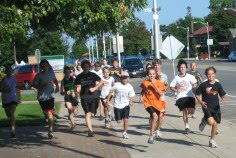Small Town Urban Ag Reason #5: Food Deserts
Thursday, December 3, 2009
Author's Note: Home Run Innovations, Inc. plans to start an urban agriculture center modeled after Growing Power farm in Milwaukee. But the center will be launched in rural Delta County, Michigan. Is this folly? Does a small community really have the same "food desert" issues that Will Allen found in Milwaukee when he purchased that first 2-acre farm that now feeds 10,000 residents? Depending upon one's personal circumstances, the answer is "yes" - and perhaps critically so.
How far can a person possibly need to travel to get food in a small Upper Peninsula town? Small towns are...well, small. Right? You don't have to navigate eight lanes of traffic on a major interstate to get to the grocery store when you live in a small town. A long work commute is any drive longer than eight minutes. My brother-in-law, the California English professor, refers to his old Upper Peninsula home town as "Chickenpoop." So really, what's this concept of "food deserts" got to do with us?
The Mari Gallagher Research & Consulting Group has been studying food deserts across the United States. They define a food desert as "large and isolated geographic areas where mainstream grocery stores are absent or distant."
How far can a person possibly need to travel to get food in a small Upper Peninsula town? Small towns are...well, small. Right? You don't have to navigate eight lanes of traffic on a major interstate to get to the grocery store when you live in a small town. A long work commute is any drive longer than eight minutes. My brother-in-law, the California English professor, refers to his old Upper Peninsula home town as "Chickenpoop." So really, what's this concept of "food deserts" got to do with us?
The Mari Gallagher Research & Consulting Group has been studying food deserts across the United States. They define a food desert as "large and isolated geographic areas where mainstream grocery stores are absent or distant."
Delta County has a population density of 32 persons per square mile. Escanaba, the county seat, has a whopping 12,297 current residents. Within the city limits of Escanaba it's often possible to walk for an hour along the shoreline of Lake Michigan or near fields on the west side of town without coming closer than a half mile to another human - hardly what most would call "urban." However, the U.S. Census Bureau defines an urban area as: "Core census block groups or blocks that have a population density of at least 1,000 people per square mile (386 per square kilometer) and surrounding census blocks that have an overall density of at least 500 people per square mile (193 per square kilometer)." At an average density of 965 persons per square mile, Escanaba sits on the fence between urban and rural. Every other Delta County city, township or crossroads falls unequivocally into the rural category.
The housing boom went bust before ever finding its way to Delta County. Old farm fields lay idle outside the city limits, having escaped conversion to suburban sprawl. Idle is the operative word, though. Few of these fields are still farmed, and the ones that are grow crops more for deer than for humans. There are exceptions. We have two successful potato farms, u-pick strawberry and pumpkin farms and one very small-volume consumer supported agriculture farm. The local farmers markets struggle and some vendors buy produce from Wisconsin farms a few hours away, causing arguments among them about what defines "local." As in every other community across the United States, local agriculture has faded out in favor of industrialized agriculture. We import almost all of the food we consume from very great distances.
Once our food has traveled great distances to land in our grocery stores, does that mean we're all home free and well fed? Not necessarily.
If you study a Google map of Delta County, and Escanaba in particular, you will find that no residence within city limits is much farther than 2 miles from a grocery store, and most places are closer than that to the nearest restaurant. A full mid-day meal is served for free Monday through Saturday in Escanaba soup kitchens - and these meals are far better balanced than the average school hot lunch. At least three area agencies or churches operate food pantries and will supply a 40 pound box of food, plus meat at least once per month to any family or individual requesting one. Hunger does occur sometimes. But for the most part, any resident of Delta County who requests food assistance will have his request granted. On the surface, calories would appear to be affordable and accessible despite lower than average household and per capita incomes.
Yet referring again to those Google maps, you can identify a trailer park on the west side of the airport. Lot rents and mortgages are relatively inexpensive in this portion of the city. However, to live there requires automobile transportation. The neighborhood is at least 2 miles from virtually all shopping, including grocery stores, with the exception of one convenience/gas station. A bicycle with large saddle baskets and a cooler strapped to the back fender might suffice in fair weather for a healthy individual, but winters in Escanaba can be harsh and at times brutally cold. It often takes a few days before city crews plow bike paths after a snowfall, and weeks before the city will issue a citation to a resident for not shoveling her sidewalk. Like many, if not most cities in the United States, Escanaba and all other communities in Delta County have evolved around the automobile, with bi-pedal transportation a vague after-thought. (Note: the one major exception is that Escanaba has been progressive by providing ADA accessibility to all sidewalks in the city.) The shopping logistics from this west side neighborhood are typical. For the vast majority of Delta County residents, food shopping without an automobile requires a half day time commitment and really strong arms and legs. If you don't live in the city limits of Escanaba and Gladstone, the two largest towns, it is practically impossible to obtain any food without automobile transportation, and virtually impossible during winter months. If you doubt me, try carrying a full grocery bag down a sidewalk (if you can find a sidewalk) in Delta County during the month of February - while the north wind is blowing.
The housing boom went bust before ever finding its way to Delta County. Old farm fields lay idle outside the city limits, having escaped conversion to suburban sprawl. Idle is the operative word, though. Few of these fields are still farmed, and the ones that are grow crops more for deer than for humans. There are exceptions. We have two successful potato farms, u-pick strawberry and pumpkin farms and one very small-volume consumer supported agriculture farm. The local farmers markets struggle and some vendors buy produce from Wisconsin farms a few hours away, causing arguments among them about what defines "local." As in every other community across the United States, local agriculture has faded out in favor of industrialized agriculture. We import almost all of the food we consume from very great distances.
Once our food has traveled great distances to land in our grocery stores, does that mean we're all home free and well fed? Not necessarily.
If you study a Google map of Delta County, and Escanaba in particular, you will find that no residence within city limits is much farther than 2 miles from a grocery store, and most places are closer than that to the nearest restaurant. A full mid-day meal is served for free Monday through Saturday in Escanaba soup kitchens - and these meals are far better balanced than the average school hot lunch. At least three area agencies or churches operate food pantries and will supply a 40 pound box of food, plus meat at least once per month to any family or individual requesting one. Hunger does occur sometimes. But for the most part, any resident of Delta County who requests food assistance will have his request granted. On the surface, calories would appear to be affordable and accessible despite lower than average household and per capita incomes.
Yet referring again to those Google maps, you can identify a trailer park on the west side of the airport. Lot rents and mortgages are relatively inexpensive in this portion of the city. However, to live there requires automobile transportation. The neighborhood is at least 2 miles from virtually all shopping, including grocery stores, with the exception of one convenience/gas station. A bicycle with large saddle baskets and a cooler strapped to the back fender might suffice in fair weather for a healthy individual, but winters in Escanaba can be harsh and at times brutally cold. It often takes a few days before city crews plow bike paths after a snowfall, and weeks before the city will issue a citation to a resident for not shoveling her sidewalk. Like many, if not most cities in the United States, Escanaba and all other communities in Delta County have evolved around the automobile, with bi-pedal transportation a vague after-thought. (Note: the one major exception is that Escanaba has been progressive by providing ADA accessibility to all sidewalks in the city.) The shopping logistics from this west side neighborhood are typical. For the vast majority of Delta County residents, food shopping without an automobile requires a half day time commitment and really strong arms and legs. If you don't live in the city limits of Escanaba and Gladstone, the two largest towns, it is practically impossible to obtain any food without automobile transportation, and virtually impossible during winter months. If you doubt me, try carrying a full grocery bag down a sidewalk (if you can find a sidewalk) in Delta County during the month of February - while the north wind is blowing.
Once upon a time there were little neighborhood markets, bakeries and dairies all over the county. But they have long since been driven out of business by large volume stores. Even if someone wanted to re-open one of these old markets to fill a specialized niche, they would now face zoning and regulation obstacles prohibiting their operation. Now when the weather looks like this, you'd better have a friend or relative with an automobile to get you to the grocery store or be prepared to spend a portion of your food budget on cab fare or bus transportation, costing anywhere from $4 to $18 per round trip.
Mainstream grocery stores are not particularly accessible to most residents in Delta County and in many towns they are completely absent. Therefore many, if not most neighborhoods qualify as food deserts.
How does the food landscape look in your small town?
Next up: Small Town Urban Ag Reason #4: Health and Nutrition
Mainstream grocery stores are not particularly accessible to most residents in Delta County and in many towns they are completely absent. Therefore many, if not most neighborhoods qualify as food deserts.
How does the food landscape look in your small town?
Next up: Small Town Urban Ag Reason #4: Health and Nutrition

Home Run Events: Innovative Ideas for Community Revitalization by Roberta (Bobbie) Stacey is licensed under a Creative Commons Attribution-Noncommercial-No Derivative Works 3.0 United States License Read more...










